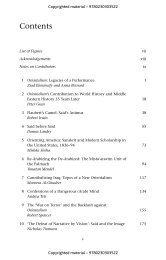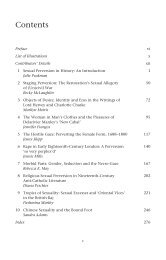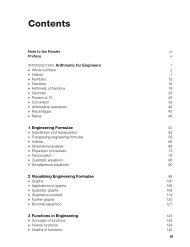Download sample chapter - Palgrave
Download sample chapter - Palgrave
Download sample chapter - Palgrave
Create successful ePaper yourself
Turn your PDF publications into a flip-book with our unique Google optimized e-Paper software.
Copyrighted material – 9781137343512<br />
4 / florence vatan and marc silberman<br />
In the European context the competition among victims can hardly be<br />
dissociated from the competition of memory paradigms. After the collapse<br />
of the Soviet Union the memory of the Holocaust—with Auschwitz as its<br />
iconic site and official symbol—emerged as the dominant model of reference.<br />
Yet the diffusion, cosmopolitization, and transnationalization of this<br />
Holocaust paradigm elicited opposition. In Eastern Europe this model of<br />
reference has been perceived as a Western form of cultural imperialism,<br />
ignoring victims of communist occupation and failing to do justice to local<br />
heritage communities. Some memorial sites attempt to reconcile competing<br />
memories and to accommodate different groups of victims by creating<br />
supplemental exhibitions or different routings in their space. These topographical<br />
and makeshift architectural solutions testify to the difficulty of<br />
addressing diverging or irreconcilable paths of memory. When consensus<br />
prevails that the past—whatever its painfulness—should be acknowledged<br />
and confronted, the modes of commemoration still raise vexing questions<br />
on how to represent violence. 4 One of the well-known paradoxes of memorialization<br />
resides in the self-defeating visibility of public displays that<br />
“bury” the past and promote forgetting rather than remembrance. Early<br />
on Nietzsche’s critique of monumentalization and Robert Musil’s ironic<br />
observation about the way great men are pushed “into the sea of oblivion<br />
with, so to speak, a commemorative stone around their necks” have<br />
pointed to the anesthetizing power of commemorations. 5 To counter the<br />
conventional memorials’ tendency to “seal memory off from awareness,”<br />
artists have privileged voids, absence, invisibility, or vanishing monuments<br />
as a way to suggest loss, challenge the monumental taste of authoritarian<br />
regimes, and keep the work of memory alive. 6<br />
The representation of violence remains a challenge from an aesthetic<br />
and ethical viewpoint. How should one make death and terror visible in a<br />
meaningful and ethically relevant way? If the duty to remember implies<br />
an obligation to imagine what defies imagination—as a way to resist<br />
the perpetrators’ wish for the total erasure of the victims—what are the<br />
appropriate channels to perform this task? The commodification of violence<br />
in the media and entertainment industry generates sensory overload<br />
and emotional numbness. It is easy to look at violent images without seeing<br />
them or being affected by them. Viewers become passive bystanders<br />
of a spectacle that does not directly concern them. Alternatively, complacent<br />
displays of violence nurture voyeurism and sensationalism, preventing<br />
self-reflection and attention. One might think, as Andreas Huyssen<br />
suggests, that in a culture dominated by fleeting images and immaterial<br />
modes of communication, monuments and memorials become salient as<br />
a result of their materiality and spatial inscription. 7 Yet memorial sites<br />
are not immune to the dangers of commodification and derealization.<br />
Copyrighted material – 9781137343512
















